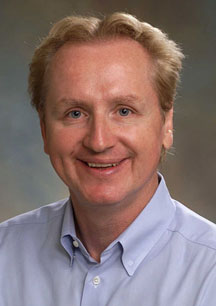

New Technologies, New Collaborations
By Mika Ono
What does the powerful new technology on the Florida campus of The Scripps Research Institute mean for the institute's La Jolla faculty? A world of new possibilities for research and collaboration.
"This new technology isn't just a Scripps Florida initiative," says Richard A. Lerner, president of The Scripps Research Institute. "It's a Scripps Research program that opens new avenues of investigation for faculty on both coasts."
Similar to platforms used by the pharmaceutical industry, the system is one of the first of its kind in the nonprofit sector. The equipment relies on automated robots to analyze a large number of compounds at once, a "high-throughput" approach that offers scientists a method to determine which of many compounds offer promise for further investigation. The technology can be applied to basic research questions or drug discovery programs.
"We want everyone at Scripps Reserach to be able to leverage our automation systems for functional genomics and small molecule discovery," says Steve Kay, chair of the Biochemistry Department. "We're thrilled by the possibilities for bi-coastal collaborations."
And many La Jolla investigators seem interested in the opportunity. Last week, more than 300 California scientists and staff packed the West Coast campus's Timken Amphitheater to hear presentations about the new platform.
After an introduction by Kay, three speakers described efforts up and running in Florida:
- Patrick Griffin, professor in the Department of Biochemistry and head of the Drug Discovery Program, provided an overview of the preclinical therapeutic discovery programs, providing examples of drug pipeline capabilities such as lead identification, medicinal chemistry, drug metabolism and pharmacokinetics (DMPK) profiles, and pharmacology, as well as programs targeted at therapeutic areas such as neurodegeneration, cancer, and cardiovascular disease.
- John Hogenesch, professor in the Department of Biochemistry and head of Genome Technologies, described several tools designed to provide a more rapid approach to identifying novel components of biological signaling networks. The Cell-Based Screening Program, which provides researchers access to arrayed collections of 40,000 cDNAs and 21,000 siRNAs (representing 7,000 genes), can be used to assign novel functions to genes. This powerful platform has already led to several high profile publications.
- Finally, Peter Hodder, head of Lead Identification in the Drug Discovery Program, spoke on an advanced robotics system focusing on uHTS in live cells and purified protein targets. A chemical library of over 600,000 highly diverse structures enables screening of a wide range of cell types and targets. Screens are supported through a collaborative mechanism so Scripps Research investigators can generate data for grant applications.
"The presentations were a tour de force on cutting-edge technologies in genomics and small molecule discovery," comments Associate Professor Dan Salomon. "They sent me back to the lab to look at my own work. What kind of questions could these technologies help me answer? What parts of my research could draw on these resources in the future? And how important are my lab's questions to the bigger pictures of science and medicine? I believe these new resources will be of huge value to the Scripps Research community."
Associate Professor Dong-Er Zhang also found the information exciting. "The high-throughput screening capacity will allow us to perform certain experiments almost impossible to do using traditional technologies," she says. "I have started discussing possible collaboration projects."
Both Salomon and Zhang look forward to additional cross-campus seminars.
For more information on the January 18 seminar, see
http://www.scripps.edu/florida/collaborations/hts/htsmeeting011806.html
Send comments to: mikaono[at]scripps.edu

Steve Kay, chair of the Biochemistry Department, introduced last week's seminar on the institute's new high-throughput system.
